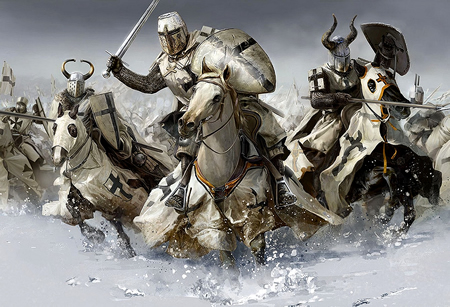 |
| Knights Templar |
At the time of the First Crusade (1096), Christian monasticism had been in existence since the third century after Christ. What developed out of the crusade, however, was a unique melding of Christian monasticism with the idea of crusade against the Muslims. The most spectacular result was the founding of the three most famous orders of “warrior-monks,” the Knights Templar, the Knights Hospitallers, and the Teutonic Knights.
The Knights Templar (originally the Poor Knights of Christ and the Temple, which is in Jerusalem) were founded around 1118 to help the newly established kingdom of Jerusalem defend itself against its Muslim enemies and to protect the large numbers of Christian European pilgrims traveling to Jerusalem.
The Templars were organized as a monastic order, following a rule devised for them by Bernard of Clairvaux and taking the traditional threefold vow of poverty, obedience, and chastity. Nonetheless, the Templars were primarily a military order, living under a grand master (elected by the members and serving for life) who was directly responsible only to the pope.
 |
It did not take long for the Templars to become a powerful religious and secular movement in medieval society. They were granted several extraordinary endowments by popes, including the ability to levy taxes and control tithes in the areas under their direct control.
Contributions of money and property from members joining the order, along with loaning funds to pilgrims, ensured that by the end of the 11th century the Templars had extensive wealth in money and land holdings stretching from the Holy Land to England.
 |
| Knights Hospitallers |
The fall of the Templars was probably the result of the animosity harbored against them by the king of France, Philip IV (the “Fair”), when the order refused to make him a loan to finance his wars. Philip pursued them with a bloody vengeance, eventually persuading the pope, Clement V, to excommunicate the order. The dissolution of the Templars in 1312 effectively broke the order, and much Templar property was transferred to the Hospitallers.
The Knights Hospitallers (or Order of the Knights of the Hospital of St. John of Jerusalem) began as a Benedictine nursing order founded in the early 12th century about the same time as the Templars. As the Templars, they were originally conceived as a protective and medical force for pilgrims to the Holy Land. They, too, were a monastic order, adopting a black surcoat with a white cross, and would eventually compete with the Templars for prestige and infl uence throughout Europe.
After the fall of Acre in 1291, the order moved to the island of Cyprus. Difficulties there forced the Knights to move to the island of Rhodes, which, after two years of campaigning, they captured in 1309. Based on Rhodes, the Knights (now known as the Knights of Rhodes) did significant damage to Muslim shipping and Barbary pirates.
Nonetheless, the Knights withstood two invasions by the Turkish empire, one in 1444 by the sultan of Egypt, and a more impressive attack by the Turkish sultan Mehmed II in 1480. In the summer of 1522 however the Turkish sultan Suleiman the Magnificient besieged Rhodes with a force of over 200,000 men against some 7,000 Knights. After a six-month siege the Knights eventually capitulated.
The remaining Knights were allowed to leave Rhodes, eventually settling on the island of Malta. Now known as the Knights of Malta, they were attacked by Ottoman Turkish forces, eventually destroying the Ottoman navy at the Battle of Lepanto (1571).
When Malta was captured by Napoleon in 1798, the Knights lost their island stronghold. In 1834 the order established a new headquarters in Rome, known today as the Sovereign Military Order of Malta.
 |
| Teutonic Knights |
The Teutonic Knights were founded in 1190 at the time of the Third Crusade by German lords fighting in the Holy Land. Like that of the Templars and Hospitallers their original purpose also included the care and welfare of pilgrims. It was not long, however, until they transferred their interest from fighting in the Holy Land to fighting Muslims in Germany’s eastern frontier.
Wearing a black cross on white surcoats, the Teutonic Knights fought equally against Christians and heathens in eastern Europe and were essentially a state in the guise of a religious order, conquering Prussia from the Slavs and pushing into Lithuania, Estonia, and Russia.
In 1410 at the Battle of Grunwald (Tannenberg), a Polish-Lithuanian army defeated the order and effectively ended its military power. In 1809, Napoleon dissolved the order and it lost its last secular holdings. The order operates today primarily as a charitable organization.
EmoticonEmoticon